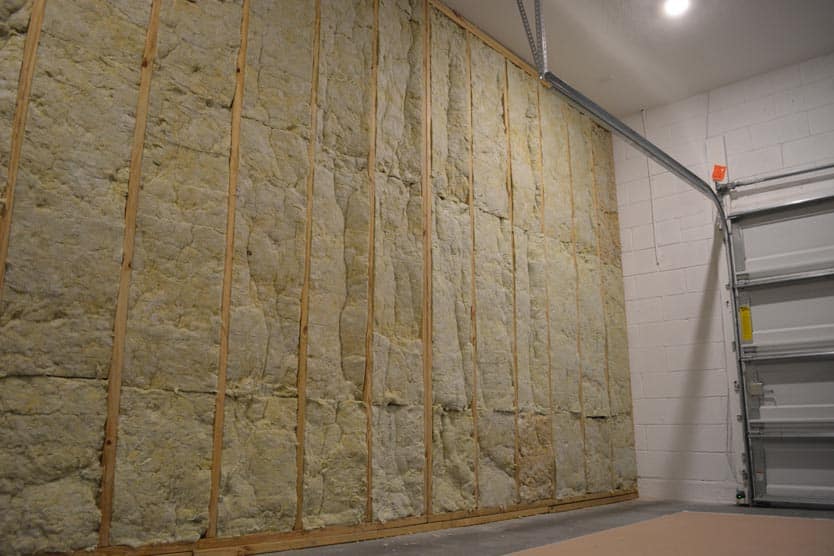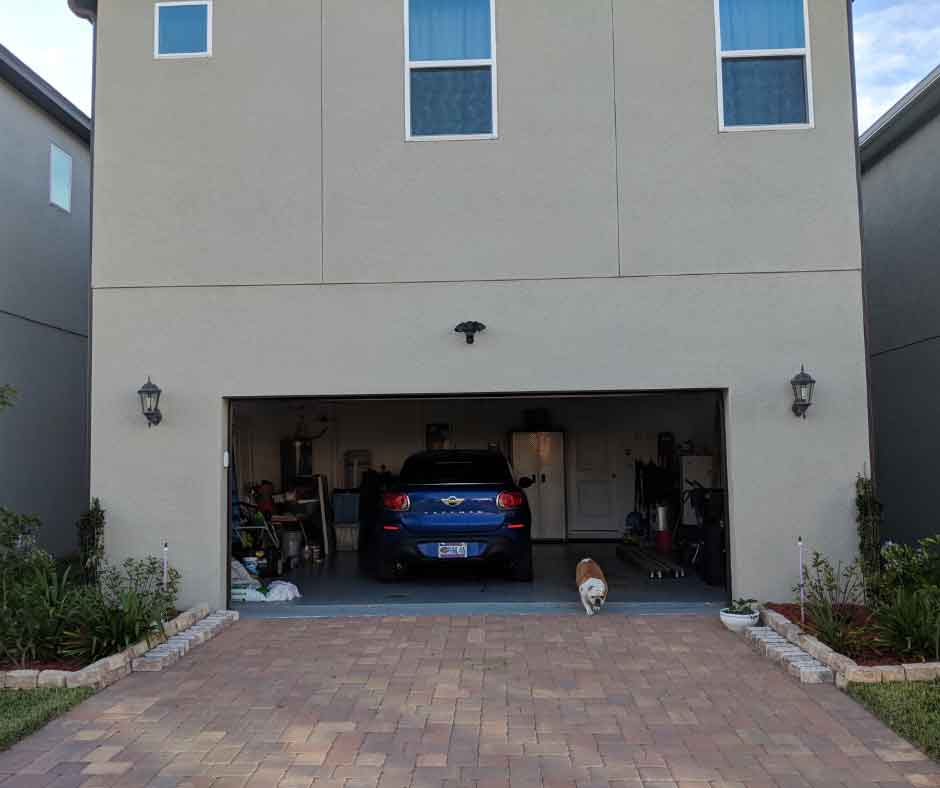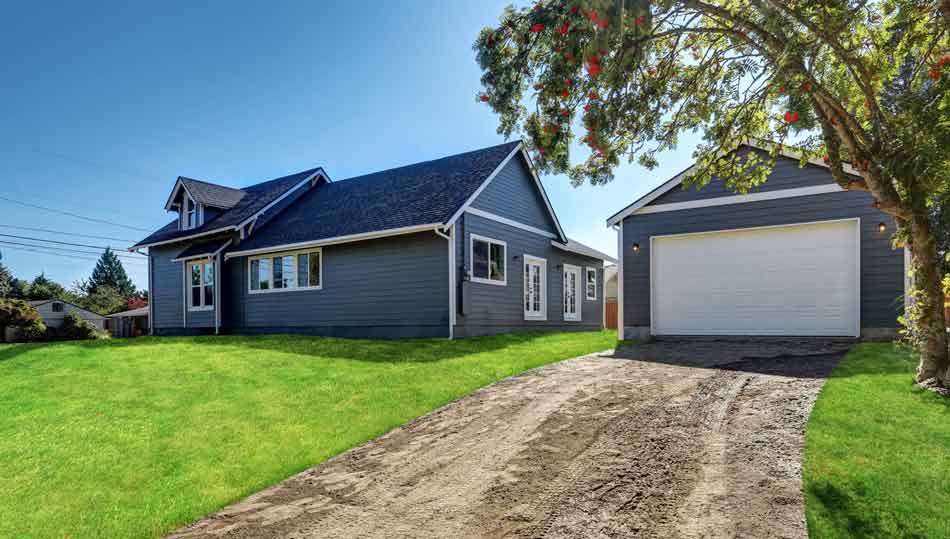I’ve taken the time to frame, insulate and drywall my garage walls, so I often get asked, would I do it again? Is insulating your garage worth it? Do I recommend it to others?
Like most things, it depends.
If you have an attached garage that’s actively heated or cooled, then you should definitely insulate your garage! Insulation is the single most significant factor in lowering your energy costs. Detached garages are usually only worth insulating if you spend a lot of time there in extreme temperatures. Anything between those two extremes depends on your situation, where you live, and how you use your garage.
Let’s start with why you might consider insulating your garage walls and door. Then I’ll give my recommendations about insulating attached and detached garages before finishing with the most important part: how much it costs.

Why Should I Insulate My Garage?
If you’re like most people, there are two main reasons why people consider insulating their garage: energy savings and regulating temperature.
The first thing you should do is ask yourself which camp you fall into.
Saving Money on Energy Bills
Anyone with a heating system or air conditioner in their garage will fall into this category.
Whether you have one of the best garage heaters in the freezing Minnesota winters or air conditioning in the hot Arizona summers, this would apply to you. If you have an attached garage with sleeping space above it, you’ll also want to pay close attention here.
Remember when your parents would yell at you for opening the windows when the air conditioning was on?
“I’m not paying to cool the outside!!” my dad would yell.
It’s the same principle as your uninsulated garage, but you don’t need to insulate the entire garage to make a dent in your energy bills.
Simply adding garage door insulation and sealing air gaps can significantly impact your electricity costs.
Regulating Temperature
Even if you don’t plan on adding heating or air conditioning, garage insulation can still help regulate the temperature and humidity.
Studies have shown that adding insulation can make the temperature 10-15 degrees (Fahrenheit) more comfortable (warmer or cooler) than the outside air.
10-15 degrees may not sound like that much. Still, when the outside temperature is below freezing, it is enough to keep your ice-cold beer from actually turning into ice.
Insulating an Attached Garage
Insulating your garage should be a no-brainer if you have an attached garage with living space above. At minimum, you should have an insulated garage door and insulation between your garage ceiling and the floor above it.

Most heat transfer (in or out of your garage) will occur through your garage door, especially if it’s a steel garage door. Steel (or any metal) is a great conductor of heat, so you’ll definitely want a high R-Value garage door here.
For more information on what R-Value a garage door should have, check out my recommendations here.
Similarly, if you have living space above your garage like I do (my master bedroom), insulating your garage ceiling is critical. You want the heat and air conditioning to stay where you want it and not spill over into your unconditioned garage space.
Think of it this way. Would you want the cold air from your garage to seep into your bedroom in the winter?
Of course not.
That said, you may not need to insulate garage walls as well.
Depending on your home’s facing and exposure, your uninsulated garage walls may be sufficient. For example, my garage door faces south, but my neighbors are both close enough that they shield my garage from the sides.
Spray foam insulation is an inexpensive was to add garage ceiling insulation while rigid foam is a better option for garage doors.
Finally, if you have taken the time (and money) to actively heat or cool your garage, you want that investment to pay off.
Seriously, why spend the money heating your garage if all that heat goes right through the garage door.
Insulating a Detached Garage
I’ve said it before: If you’re spending the money to actively heat or cool your garage, then insulation should be on your list.
Otherwise, you’re just throwing money out the window.
That said, homeowners with detached garages should take a more measured approach to insulation than those with attached garages.
If you have invested in heating or air conditioning, I recommend an insulated garage door, even if you have a detached garage. Then, replace your door and window seals and call it a day.
Insulating garage walls would be overkill in this situation.

What if you’re not actively heating or cooling your detached garage?
Then it’s a bit iffy.
For the most part, insulating a detached garage that isn’t actively heated or cooled isn’t cost-effective. As I’ve mentioned, the temperature difference will only be about 10-15 degrees from the outside air.
Because it’s a detached garage, you’re not going to be concerned about any heat transfer to interior living spaces because, well…there aren’t any adjacent rooms.
I would only consider insulating my detached garage if I lived in a freezing climate and I needed to spend a lot of time working in the garage.
Even then, I’d only insulate the garage doors and windows. Think of it as a stop-gap measure before installing some active heating.
For most parts of the country, I would spend that money on other things.
How Much Does it Cost to Insulate a Garage?
Brand new insulated garage doors can cost between $3000 and $5000, once the labor is added in. However, you can add a garage door insulation kit for as little as $100. It’ll go a long way to making your garage more comfortable.
I installed the Matador garage door insulation kit for around $200 for my 2-car garage door. Click on that link to see how easy that DIY garage insulation project was!
If that’s not enough, you can insulate the garage walls as well.
I added fiberglass insulation and drywall to the garage wall that gets the most direct sunlight, which made a big impact. I spent just over $350 for the materials, but you can see the complete breakdown of how much it costs in this article.
When I say that it had a significant impact, I want to set the right expectations.
I’m talking about a 10-15 degrees difference one way or the other. In my experience, I went from regularly having temperatures over 90 degrees in the summer to temperatures in the low-80s.
In Florida, that’s the difference between oppressive heat and mildly warm.
Wrapping It Up: Where You Live Matters
Depending on where you live, it may not make sense for you to insulate your garage.
If you live in the hot and humid south like I do or up in the frozen north, insulating your garage will increase energy efficiency and save money on your energy bill.
However, if you live somewhere the temperature is mild year-round with only small chunks of time that are extremely hot or cold, then don’t bother. Count yourself lucky and move on.
Or…if you live someplace milder and you REALLY want to get some sort of garage insulation, then look at insulating your garage door. However, that would be as far as I go.
